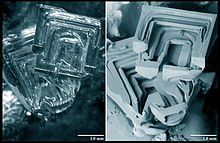Swimming snow
Swimming snow (also called deep hoar ) is a type of snow with a special crystal shape that arises in the course of the structural transformation . It is an essential and particularly treacherous factor in the formation of slab avalanches .
Emergence
Freshly fallen snow shows the classic snow crystals in their hexagonal structure. Depending on various factors, including a. Temperature and exposure to the sun, these transform themselves more or less quickly into coarse-grained old snow crystals, which are characterized by a good bond and a corresponding strength (this process is called degrading transformation). For this reason, among other things, the avalanche danger usually decreases significantly in most exposures a few days after the last snowfall .
When the temperature gradient in the snowpack exceeds approx. 0.25 ° C / cm, the coarse-grained old snow crystals transform again and form the characteristic goblet shapes ( cup crystals ) of the swimming snow. This process is promoted in particular by an inhomogeneous layer structure, since hard snow layers with their larger number of ice crystals are more thermally conductive . For example, there are particularly sharp jumps in temperature under hard layers, as a result of which the snow below is built up into swimming snow.
Significance for avalanches
Due to its crystal structure, swimming snow has a poor or no internal bond. Therefore it trickles like sugar when it is sprinkled out of the hand and forms the sliding layer for a possible slab of snow: the layers above can slide on the unstable layer of floating snow (they "swim"). Especially with the typical combination of swimming snow under harsh, the harsh layer in particular can transmit extreme forces, so that snow boards of gigantic dimensions can arise here.
The particular danger of swimming snow compared to other potential sliding layers such as snow-covered hoar frost is that it arises afterwards; as a result, an already safe slope can later be at risk of avalanches again. The existence of conditions under which swimming snow is created is also much less obvious than, for example, the formation of frost or drift snow .
See also
literature
- Michael Hoffmann, Avalanche Danger , BLV, 2000, ISBN 3-405-15974-1
- Werner Munter, 3x3 Lawinen , Pohl & Schellhammer, 2003, ISBN 3-00-010520-4

